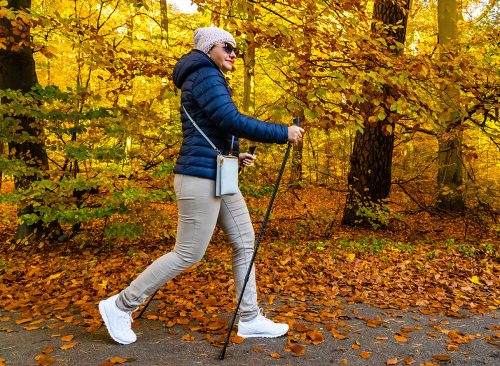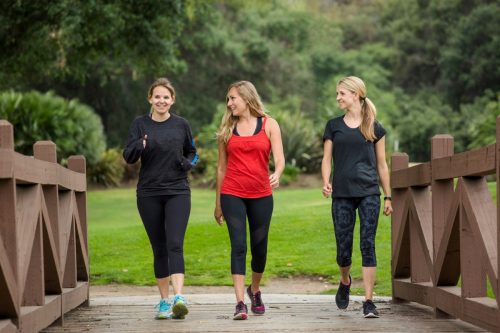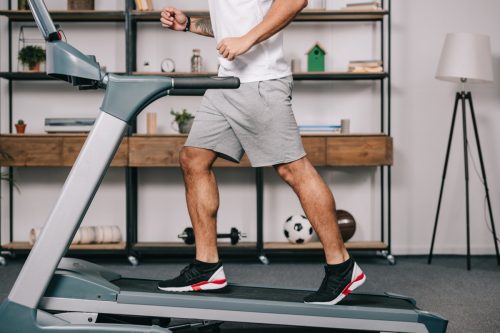Walking is one of the simplest and most effective ways to improve your health and fitness. In this article, we explore nine walking workouts designed to help you maximize the benefits of this everyday activity. Best Life talked to Dr. Milica McDowell, VP of Operations at Gait Happens, and other pros, to gather expert-approved strategies that will enhance your physical and mental well-being. From varied environments to progressive challenges, each workout is crafted to suit different preferences, whether you prefer the convenience of a treadmill or the tranquility of a nature walk. Incorporate strength training, mindful reflection, or even travel-based walking adventures to keep your routine exciting and effective. Get ready to transform your walks into powerful workouts for optimal health benefits.
RELATED: 15 Simple Ways to Maximize Burning Fat While Walking

Dr. McDowell suggests: “Indoor walking on a treadmill is a great alternative to outdoor walking. It provides just as many benefits as outdoor walking and is a more convenient option since you can hop off at any time, unlike an outdoor walk! Also, a treadmill is more forgiving on your joints and spine than walking on outdoor concrete, sidewalks, or pavement.” She continues: “Nature walks and outdoor walks in green spaces have a proven ability to improve your mood and mental clarity! Nature walks can also improve your Vitamin D levels especially if you take an early morning walk!”

Dr. McDowell advises on challenging yourself: “You can challenge yourself when walking by increasing one of the following parameters. You don’t change more than 1 per session, so your body has a chance to adapt to the workout.
Increase cadence. Cadence is your walking speed, and it ties to fitness and can accelerate your workout if you are pressed for time. Shoot for 100-120 steps per minute.
Backwards walking. Yes, it sounds surprising, but introducing some minor bouts of backward walking can be a unique stimulus to your body and will mix up the demands on your brain and posture systems. Don’t try this if you have balance issues or a history of falls! If you don’t have either of those factors in your history, try adding 30-60 seconds of backward walking during your walk. Shoot for 3-5 bouts, and you’ll see gains in your glues, hips, and back.
Add walking poles. Nordic walking is the term for walking with poles. It allows you to engage your arms and your abs more than walking without poles. It can allow you to go longer (duration-wise) and higher (elevation-wise) and can help you gain more strength than walking without poles.”

“Adding load to your walk is a way to add a strength training component to your walk. Hand weights are an easy way to do that, or you can try ‘rucking,’ which is to add a small loaded backpack to your walk. I’d suggest trying these add-ons for less than 10 minutes (or less than 50% of your walk duration) to see how your body responds,” Dr. McDowell recommends.

“An ideal walking gait starts with outside (lateral) heel contact, weight shifting through the middle of the foot, and then push off of the big toe (medial) side of the foot,” Dr. McDowell explains. “When you are walking, focus on even contact on the right vs left foot, even symmetrical arm swing, and upright posture. Keep your gaze ahead, your head in neutral (never text and walk!), and your abs pulled back toward your spine. Final pro tip, Breathe! You’d be surprised how many folks forget to work on their breathing when they are walking, so focusing on equal lengths of inhale and exhale activates your diaphragm muscle and enhances core and pelvic floor control.”

“Begin by breaking your walks into smaller portions that are manageable for your current fitness level,” says Caitlin Donato, Director of Fitness at Pritikin Longevity Center. “Begin with an initial goal of three 10-minute walks throughout the day. Give yourself as much time as needed to recover between walks. Once you feel successful with step one, add a heart rate monitor and/or use the rate of perceived exertion (RPE) scale to assess your efforts on the walks. If you are using a heart rate monitor, you are looking to work to 70-75% of your maximum heart rate. If you are using the RPE scale, your goal should be to walk at a pace that feels somewhat hard. You should be able to maintain a conversation, but that conversation should sound breathy. Once you feel successful breaking your walks into three ‘somewhat hard’ 10-minute sessions, you can progress again and combine those efforts into one ‘somewhat hard’ 30-minute walking session.”
RELATED: 7 Walking Mistakes You’re Making—And How to Fix Them

Emily Sloan, LPC, SEP, recommends a “Reflection Walk”: “This is particularly beneficial for people that don’t like to journal. It starts with a journaling prompt or reflection question. Take that prompt/question with you on a walk (preferably in nature) without headphones. Allow yourself to ponder and reflect on the question to see what arises from within. The bilateral stimulation of the walking (back and forth – left to right movement) is extremely helpful in allowing the brain to process. This is the basis of EMDR therapy, which is a highly effective mental health therapy. Notice any insight or clarity that arises during the walk.”

Halona Black, writer and meditation teacher, shares: “My tip is to not be afraid to look into local and international races as they are not only for runners. A marathon that is advertised for runners will also have shorter distances that fit people who love to walk — a 3K or 5K race, for example. It’s a great way to travel in your state, or even abroad, as I choose to do.”

Joy Puleo, NPCP, ACSM, and Director of Education at Balanced Body, suggests: “Three ways to add intensity, challenge, and diversity are to consider the following:
Intervals: Vary your speed by creating intervals where you are walking at a relaxed pace followed by short intervals increasing speed.
Incline/Decline: Adding inclines and declines will both increase the challenge and change up the routine while keeping the mind in tune with the body and elevating heart rate.
Fitness moments: Adding squats, lunges, and other fitness-based calisthenics are a great way to mix up your walking routine.”

Sarah Bowmar, certified personal trainer and health coach, advises:
“Don’t hold on to the handles if walking on the treadmill. It causes you to be hunched over and messes up your posture. While walking, keep your posture as straight as possible. If walking on an incline – don’t walk ‘lazily’ walk with purpose and with intention. If you don’t, you won’t have proper form and can injure yourself. Start with a simple step goal such as 10,000 steps a day. Once that habit has been formed and it’s built into your routine you can build upon it such as walking more steps, adding wrist weights, walking on an incline, etc.”
